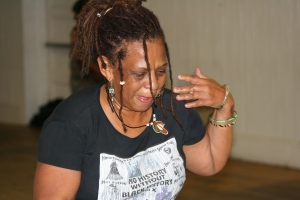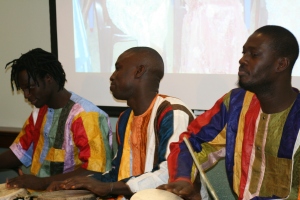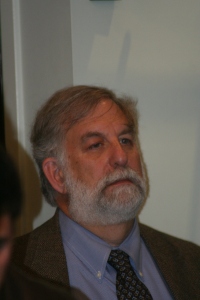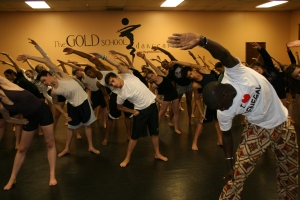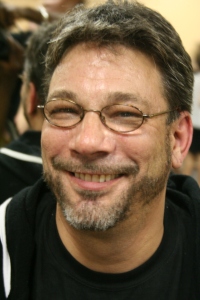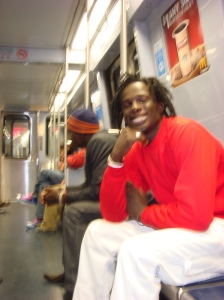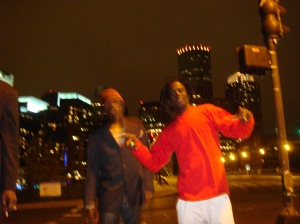In and Around Around Boston II
November 29, 2009
Drum and Dance Classes
November 29, 2009
During their residency the Faye family has played for dance classes and taught drum and dance classes in the Greater Boston area. The teachers and students of drum and dance, through their active study and support have provided a fertile ground for African culture, especially in the Cambridge/Boston communities. They have created spaces where people can engage in the collective experience of music and dance. These teachers and students have welcomed Aziz, Moustapha and Malick to take part in their classes and activities. Their participation in these classes can be considered a part of the Faye family’s residency as Distinguished Visiting Scholars at Suffolk University. As an urban campus it is consistent to extend into the communities of the Greater Boston area; the Black Studies Program, which is supporting this residency, also encourages a connection with the wider community; and it is natural for the Géwël to be active in the communities in which they are located. The photos from these classes can give a sense of the joy and exuberance that are a part of these classes.
Sabar as a Living and Modern Art, Part I
November 29, 2009
Sabar as a Living and Modern Art – Part I, Kapono Ciotti
The Origins of Dakar’s Ultra-Hip Music Scene
A storyteller once told me that ‘all stories are true, and some of them actually happened.’ All the stories I’m going to tell you today are true, and having lived in Senegal, and having traveled throughout West Africa I believe that all of these stories actually happened this way. But you can decide for yourself.
If you had the opportunity to hear Dr. Belinger’s lecture on the origins of the Faye family, or you have studied the griot of West Africa you probably have a good picture of what it means to be guewel.
The guewel are the griot, or hereditary historians of the Wolof, Serer, and Lebu of West Africa. Among other thing, their role is to keep family histories through stories and song, to be the council of leaders in the government and to be the keeps of the Sabar.
It’s their role of ‘keeping the Sabar’ that I am most concerned with today, and it’s what I am going to spend the majority of this lecture on.
You are born guewel. “Dret la”. It is in your blood. There is no substitute for guewel blood and no way of escaping being guewel if that was your born destiny.
The Senegalese Griot and the Mande Djeli
In the early thirteenth century somewhere between the current-day borders of Mali and Guinea lived the Chief Maghan Kon Fatta Konate, rule of Mande. Like the archetypal story goes, he had a royal wife and they had already had a son, Dankaran Touman, who was born to inherit the kingdom. But as fate and the gods would have it Maghan Kon Fatta Konate was meant to marry another, a woman of lowly rank and class, in fact even deformed and hunched-back woman at that. From their union was born Soundjata Keita, a boy of lowly birth, but favored by the spirits to one day unite West Africa under the Mande Kingdom. This is a long and intricate story, but one critical component was power given Soundjata by his griot or djeli, Balla Fasekke Kouyate.
In the Mande tradition the djeli is also a hereditary station in society. Story teller, singer, player of many instruments, but not the djembe, West Africa’s most popularized instrument. The djembe was reserved as the domain of the blacksmith some have said.
Today in countries that once made up the Mande Empire on is called to the djembe. There is no blood quantum requirement to play the djembe, there is no last name, or family association required to take up the art form. Schools of djembe have been set in Guinea, Mali, Burkina Faso, Cote d’Ivoire and Senegal by world-renowned musicians such as Famadou Konate, Mamady Keita, and others. Master djembe players take appranties or apprentices and pass on their knowledge to them.
In a subtle contrast, the griot, or guewel of the Wolof, Serer, and Lebu are also hereditary historians, however, their charge includes the main percussions instrument of the region, the Sabar. And it is this small difference that is the root of very important role Sabar has played in the modern music scene of Senegal.
We’ll come back to this idea in a little bit.
Lak Daro Mbaye
Sing-Sing u Birame Gueye, Kewe yaye ou Awa Diange, Badj Guewel Ndakarou.
Mali Baye Manga ak Djakheri Baye Mangi, Boubou yoroup Soumbedjoun Kewe yaye ou Menga Ndiaye. Aboulo Korothi.
Somewhere at the end of the eighteenth century or the early nineteenth century, when Dakar was still a village and the wind off of the Atlantic ocean had not yet been replaced by diesel exhaust, the Faye family patriarch, Birame Gueye Faye lived in his family compound where the neighborhood of Medina, Dakar currently stands today, the same place is ancestors, Vieux Sing Faye, Tapha Faye and Malik Faye still live. There were no city streets yet, no buses, or bikes, just walking paths from house to house and farm to farm. Like most families, the Faye family, besides being guewel kept a small farm.
Birame Gueye Faye had two sons, Mame Sing-Sing Faye and Mousse Yess Faye. Well one day as the eldest son, Mame Sing-Sing returned one evening from farming on his plot, which was located in the direction of the neighborhood called Fann, his encountered a great spirit, one named Lak Dawr Mbaye. The Lebu of Dakar have long and complex relationships with the spirits of the plateau. Each district has their own spirit, which sometimes acts as a guardian, but other times can wreak havoc on the people.
Meeting a spirit along the path home must have been startled Mame Sing-Sing at the least. He was probably in fear of his life. At this particular meeting the spirit was not in a malevolent mood and as the two talked Mame Sing-Sing offered to leave Lak Daro Mbaye offerings of millet, milk, and other foods at the ceremonial spot called a khambaye at their family compound.
Over the years this knowledge helped the family be the pre-eminent geuwel of the region.
Both brothers, Sing-Sing and Mousse Yess took up the vocation of their father, however Sing-Sing, as the older brother took on the responsibility of keeping up the relationship with Lak Daro Mbaye and Mousse Yess took on the responsibility of becoming the villages Imam, an esteemed role in a predominantly Muslim country.
These brothers were Badj Guewelu Ndakarou, or the chief griots of Dakar and had an important role as advisors to the village chiefs. This relationship between the Faye family and the government of Senegal continues today as the family’s patriarch Vieux Sing Faye is retired from his government job and still acts as chief drummer at political rallies and events as well as presiding over the Ndawrabine ceremony, a ceremony that marks Dakar’s government leaders.
Dakar’s Sabar Scene
This relationship with Lak Dawr Mbaye and their place as the Badj Guewelu Ndakarou placed Sing-Sing’s grandson, Vieux Sing Faye at the forefront of a postcolonial music scene.
As Sekou Toure, Guinea’s president was forging ties with communist Russia, and China and recruiting the counties best drummers and dancers to star in his Ballets Africans, Senegal was creating ties with Western Europe and had a much smaller cultural resurgence. However the place of Sabar remained integral to life in Dakar.
As Dakar became an international port and center of commerce, so did the it attract guewel from all across Senegal: from the region of Kaolack the Djeri Djeri family of Thio Mbaye, from Walo-Walo the family of internationally renowned drummer Doudou Ndiaye Rose, which forever changed the landscape of the sabar scene in Dakar.
As families formed their own drumming troupes in the capital city, rivalries and friendships formed. Vieux Sing Faye and his contemporaries, Doudou Ndiaye Rose and Ma Cheikh Mbaye, while being the closest of friends were also the fiercest of rivals, each, choosing his own path to fame on the sabar scene.
Each took turns filling roles in the National Ballets, each took turns on World tour, but the most coveted of positions was to be the most sought after troupe to play a Tanember.
A Tanember is the late night women’s dance gathering that is the mainstay of Dakar’s nightlife.
So at this point we pass through what we might consider history and I can start to explain how sabar created the roots of the ultra-hip music scene in Dakar.
- Kapono Ciotti presents Sabar as a Modern and Living Tradition.
Moustapha Faye, Aziz Faye and Malick Ngom demonstrated the sabar tradition both before and after the presentation by Kapono Ciotti.
Those in attendance included faculty, students, staff and members of the Greater Boston community.
- Dean Kenneth Greenberg.
An Evening at the Teranga Restaurant
November 28, 2009
On October 30, after the lecture Sabar as a Living and Modern Art by Kapono Ciotti (soon to be posted) we all went to dinner at the Teranga, the Senegalese Restaurant on Washington Street in Boston’s South End. The restaurant, owned and operated y Marie-Claude Mendy, is an excellent place to have a taste of Senegal – from the yassa poulet and the lamb shanks to the grilled fish and soupa kanja. And for our group who were all familiar with Senegalese cuisine, it was a perfect way to top off an excellent presentation on Senegal’s sabar tradition.
YOUNG ACHIEVERS SCHOOL
November 13, 2009
The Géwël Tradition Project is concerned with the passing on of the tradition to future generations. With this in mind the Faye family has been working with Kimani Lumsden’s eighth grade music students at the Young Achievers School in Matapan. They have been working on drum rhythms and bakks (musical compositions) for the past month and will begin to learn the dances that go with these rhythms during the next month. These photos capture some of the energy of the students as they take on learning this new drum tradition.
The following are portraits of the Young Achievers drum class students by Zapo.
Sing Sing At the Gold School II
November 12, 2009
On Friday, November 7, 2009 the Sing Sing family taught a dance class at the Gold School in Brockton, MA. A video and student comments were posted in part one of this entry; this part presents some photos from the evening.
Again, the Faye family and the Géwël Tradition Project wish to thank Rennie Gold for inviting us to work with the Gold School’s wonderful students.
SING SING AT THE GOLD SCHOOL
November 11, 2009
On November 7th the Sing Sing family taught a dance class to the students at the Gold School in Brockton, MA. It was an amazing experience for the students, but also for Aziz, Moustapha, and Malick. To get a feel for the high energy of the class watch the video.
Some of the comments from students who took the class, parents of the students, and alumni of the Gold School who viewed the video are below.
COMMENTS ON THE SING SING CLASS BY STUDENTS WHO TOOK THE CLASS
i loved that class!!!!!! when are we doin it again?
November 7 at 8:29am
BEST CLASS IN THE WORLD!!!!!!!!!!!!!!!!!!!!!!!!!!!!!!
November 7 at 8:46am
best class everr!!!
November 7 at 12:47pm
i am so glad that I was able to take this class. Amazing cutlure, amazing, choreography, amazing people…thank you for having them teach a class at TGS!
November 7 at 5:30pm
this class was so much fun!!! hope to do it again one day!
November 7 at 5:41pm
absolutely, positively, the best class i have ever taken. the energy surging through that room was euphoric.
November 7 at 5:56pm
this class was absolutley amazing! i loved it.
Sun at 10:03am
AMAZING CLASS!!!!!!!!!i hope we get another great oppritunity like this soon!thanks for the experience!!!
Sun at 11:15am
That class was SO much fun! I hope we can do something like that again! Best class ever!
Sun at 8:42pm
omgg lovee thatt class..hopee too do somethingg elsee like that!
Sun at 8:47pm
soooo coool
Sun at 9:44pm
COMMENTS ON THE SING SING CLASS FROM PARENTS OF STUDENTS WHO TOOK THE CLASS
Olivia loved the class!!
November 7 at 12:50pm
Noah LOVED this!!! Thanks for sharing this video!
November 7 at 10:56pm
COMMENTS ON THE SING SING CLASS BY FROM GOLD SCHOOL ALUMNI
that’s great!! and everyone was able to keep up!! how impressive
November 7 at 8:51am
“Thank you! That was incredible! What a great way to start my day…I have a smile from ear to ear!! I love it!!’
November 7 at 8:52am
wow that was amazing!!! i wish i could have been there!! u guys all rock!!
November 7 at 9:11am
Amazing. Thanks for posting!
November 7 at 9:55am
awww wish I was there for this!! we have Dunham at school and its like that…loved it.
November 7 at 10:24am
Absolutely amazing. I can feel the energy in the room just from watching through the computer. really wish i could have been there.
November 7 at 10:37am
I so enjoyed watching this. thank you for posting. Not sure if you knew this or not, but, Alison danced in Frank’s company. I loved going to his performances and shows. So much energy you wanted to jump up and dance. The drums go into your soul!!!!
November 7 at 10:50am
WOW! Get it you guys!!!!!!
November 7 at 10:53pm
COMMENT ON THE SING SING CLASS AT THE GOLD SCHOOL FROM A SUFFOLK UNIVERSITY ALUMNI
Anta Sane
"Love it prof B..congrats!!! These students have the best to teach them...indeed what a great opportunity!!
Take care, best, talk to u soon..xoxo"
Thanks to the Gold School for inviting the Sing Sing Family. Watch for the posting of photos from the class.
IN & AROUND BOSTON I
November 4, 2009
In between the activities and presentations related to the Distinguished Visiting Scholar residency, we have been able to get around Boston. Below are some photos taken by Zapo Babilee that captures some of the moments when Moustapha, Aziz and Malick were not teaching or presenting.










































